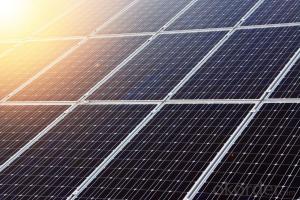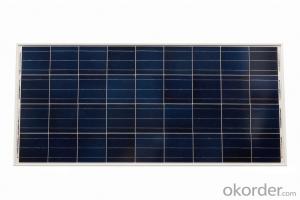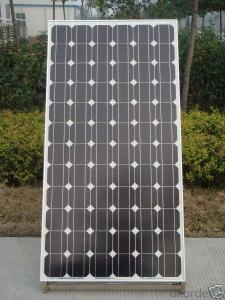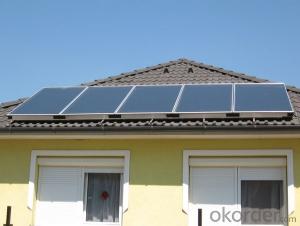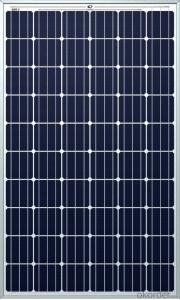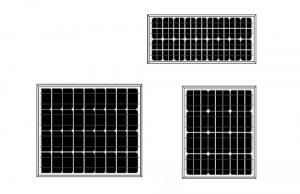Lumina Solar Panels 320w Poly Solar Module with High Efficiency
- Loading Port:
- Tianjin
- Payment Terms:
- TT OR LC
- Min Order Qty:
- 1 watt
- Supply Capability:
- 100000 watt/month
OKorder Service Pledge
OKorder Financial Service
You Might Also Like
Specification
Product Description:
1.Structure of Solar Module Description
CNBM Solar's photovoltaic module is designed for designed for large electrical power requirement. It is the optimal choice for both on-grid and off-grid power systems. CNBM Solar offers high performance of power per square foot of solar array.
2.Main Features of the Solar Module
Solar Cell: High efficency crystalline solar cell. Even if under the weak light, the solar module can produce maximum power output.
Tempered glass: Anti-reflecting coating and high transmission rate glass increase the power output and mechanical strength of solar module.
EVA and TPT: Using high quality EVA and TPT to prevent destroying and water.
Strong aluminum frames to strengthen the load hold and to stand against high wind.
Junction box: Multi function junction box with water proof.
Long lifetime: ≥25 years; Less power decrease.
Good performance of preventing from atrocious weather such as wind and hails.
Resisting moisture and etching effectively, not effected by geology.
The certificate issued by international authority: UL, TUV, IEC, VDE, CE.

Solar panel working process
In addition to being the ultimate source of all life on earth, the sun is an infinitely renewable, completely pollution-free source of electricity. Instead of burning fossil fuels dug up from the ground in a big power plant – a very 19th century, industrial age approach, when you think about it – solar panels convert sunlight directly into electricity, with no harmful emissions.
The basic unit of a solar panel is a solar cell, which usually consists of one or two layers of silicon-based semiconductor wafers. When struck by the photons in sunlight, the solar cell generates an electrical charge due to the "photovoltaic effect" – which is a pretty good name, since it produces voltage from photons. The flow of these electrons moves in a steady electrical current from one side of the cell to the other.
Dozens of these PV cells are packaged together into solar modules, which in turn are packaged into solar panels that are mounted on a rooftop and arranged to maximize their hours of exposure to direct sunlight. Because the electricity generated by all those solar cells is direct current (DC), it is then sent to an inverter that transforms the power into the same alternating current (AC) used by the appliances in your home and the local utility electricity distribution grid. Increasingly, these inverters are getting "smart," providing data monitoring for solar installation performance and other grid integration services.
- Q: Can solar panels be used to power a hotel?
- Yes, solar panels can be used to power a hotel. Solar panels convert sunlight into electricity, which can be used to meet the energy needs of a hotel. By installing a sufficient number of solar panels, a hotel can generate enough power to run its various systems, including lighting, heating, cooling, and other electrical appliances. This not only helps reduce the hotel's reliance on traditional power sources but also lowers operating costs and promotes sustainable energy practices.
- Q: How do solar panels affect the property's community image?
- Solar panels can positively impact a property's community image by showcasing the owner's commitment to sustainability and environmental responsibility. Their presence can inspire others to adopt renewable energy solutions, leading to a more eco-conscious community perception. Additionally, solar panels can enhance the property's aesthetic appeal, especially when integrated seamlessly into the design.
- Q: What about sources for straight forward solar powered products? Excluding toys, garden frogs and outdoorpath lights I have found few useful items for the home. What I have found are solar panels for under $00 each, inverters, rechargeable indoor lights and a few camping/RV products that are interesting. It seems to me that these could help me start to wean the family off the power company. I can't afford to go cold turkey and cover my roof with solar panels and I don't think the HOA would allow me to even if I could. Is anyone using solar on a small scale?
- I okorder Hope this helps.
- Q: Can solar panels be installed on a sloped roof?
- Yes, solar panels can be installed on a sloped roof. In fact, many residential and commercial buildings with sloped roofs have successfully installed solar panels to generate renewable energy. The angle of the slope can affect the efficiency of the panels, but with proper installation and positioning, solar panels can still effectively harness sunlight and produce electricity.
- Q: Can solar panels be used in cloudy regions?
- Yes, solar panels can still be used in cloudy regions. While solar panels do work best under direct sunlight, they can still generate electricity from diffused or scattered sunlight present in cloudy conditions. However, the overall energy output may be lower compared to sunny regions.
- Q: Was at home depot today and a Solar City sales man came up to me, offering me free solar panels. He said he could install them on my garage for free, free installation, free panels. Promised me it wouldn't cost me a dime. This is obviously appealing to someone like me who has a $200.00 monthly electrical bill. Now my question is this. Is this a scam? Are there ANY hidden fees or things I should be weary of?- I understand I may not save tons of money, but if I can save even something as low as $20 a month I would be happy. I live in a sunny area and they seem very interested in my garage roof. Any information would be super-helpful, thank you.
- Danny, okorder
- Q: Are solar panels safe for the environment?
- Yes, solar panels are safe for the environment. They generate electricity using sunlight, which is a renewable and clean energy source. Solar panels produce no greenhouse gas emissions, air pollution, or waste materials during operation. Additionally, they do not deplete natural resources, as sunlight is an abundant and infinite source of energy.
- Q: Can solar panels be installed on data centers or IT facilities?
- Yes, solar panels can be installed on data centers or IT facilities. In fact, many data centers and IT facilities are increasingly adopting solar energy as a sustainable and cost-effective power source. Solar panels can be installed on rooftops or in open areas surrounding the facility to generate clean electricity and reduce their reliance on traditional grid power.
- Q: China is the world's biggest producer of solar panels
- Or maybe he should increase tax benefits for domestic manufacturers of solar panels, so that they are actually manufactured here instead of in China? Oh, wait. He is. But I've seen questions in which you whine about tax cuts for renewable energy because you think renewable energy can't be profitable.
- Q: Can solar panels be used for charging laptops or smartphones?
- Yes, solar panels can be used for charging laptops or smartphones.
Send your message to us
Lumina Solar Panels 320w Poly Solar Module with High Efficiency
- Loading Port:
- Tianjin
- Payment Terms:
- TT OR LC
- Min Order Qty:
- 1 watt
- Supply Capability:
- 100000 watt/month
OKorder Service Pledge
OKorder Financial Service
Similar products
Hot products
Hot Searches
Related keywords
